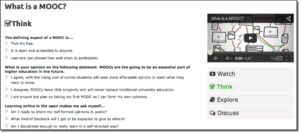Documentation:DIY Screencast/How does it support learning
Screencasts are one method of many to create video which supports learning. Uses for screencasts in learning include:
demonstrating how to use a web application or piece of software
illustrating a particular concept via a whiteboard application or animated drawing.
Creating learning wrappers for your screencasts help to support the learning outcomes your students are working towards. Learning wrappers may include:
guiding questions for student to consider when watching your screencast
a self-assessment to follow the watching of your screencast
resources to extend learning
an opportunity to discuss or work with the content in some way: this might be an in-class activity
An excellent example of the learning wrapper format is the Ted Ed initiative, which allows users to work with a Ted video, or any other video hosted on YouTube, to create a learning experience.
We modelled our own version of a learning wrapper to integrate with UBC's CMS, built on WordPress. We're piloting it on the Digital Tattoo site. If you want to test it yourself, the documentation is here.
Instructional design support
Working in Connect? Visit LTHub.
Working in WordPress? Have a look at UBC's CMS page, and register for one of the CTLT's WordPress dropin clinics.
Looking for learning/instructional design resources? Contact your CTLT learning/instructional designer, your Flexible Learning liaison, or your Instructional Support Unit for consultation.
